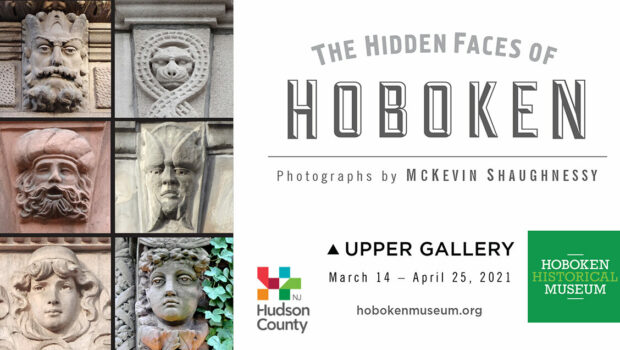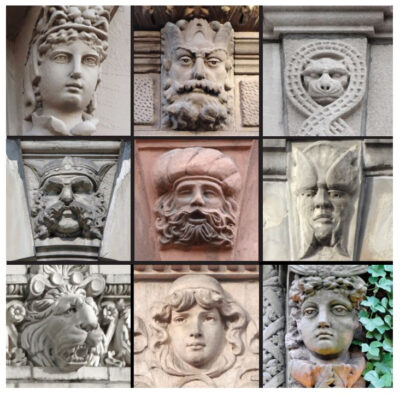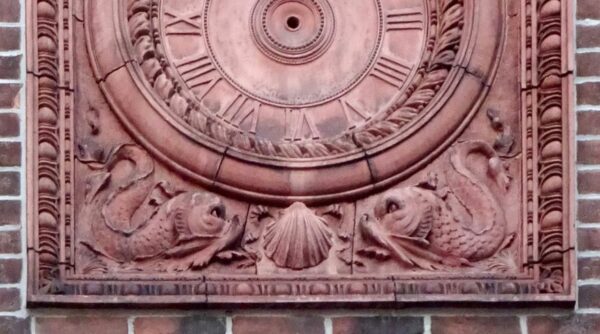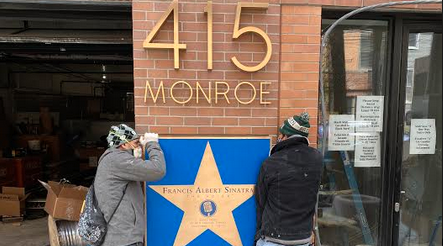
HEADS UP: Photographer McKevin Shaughnessy Profiles ‘The Hidden Faces of Hoboken’
Once renowned for the most bars per square mile, Hoboken might be in the running for yet another impressive title that puts it head and shoulders above the rest.
Artist, graphic designer and photographer McKevin Shaughnessy can now add “headhunter” to his résumé, after what began as an idle distraction soon became an obsession and eventually a pandemic project—documenting over 540 (and counting) decorative faces adorning Hoboken buildings.
“The overall variety is staggering,” he says, “from family portraits to mythical griffins, bald eagles, lion heads, imaginary beasts, Viking warriors, a sultan, numerous kings, a wolfman, the wolverine, a birdman, princesses and goddesses, cherubs and the like.”
Shaughnessy will explore “The Hidden Faces of Hoboken” via a live-streamed artist talk on Friday, March 12 at 7 p.m. His solo show opens in the Hoboken Historical Museum’s Upper Gallery starting Sunday, March 14, with a reception from 2–5 pm.
Destined to become a book project now, the exhibit will display about 20 framed images he’s taken in the past since stumbling upon the project last Thanksgiving. The exhibit will remain on view through April 25, as a testament to what Shaughnessy believes to be, “the most architectural heads in one square mile.”
We spoke with Shaughnessy to learn more about how this unique and fascinating exploration of an often overlooked aspect of architectural design.

hMAG: Is that a fact—the most heads per square mile?
McKevin Shaughnessy: Well, due to the sheer numbers, (now over 550) I would say we might have a real shot at this. Manhattan Island does have more architectural head sites, but it is 22.8 square miles big—while Hoboken, on the other hand, has just 1.25 square miles of land. (So, fingers crossed.)
H: Can you share with our readers the significance of the heads in architecture?
S: I think the methods and ideas for these were brought over from Europe. There are unmistakably similar styles of stone carvings on sites in Manhattan. With Hoboken being just across the river, it seems likely that their handiwork would show up here, as well.
Also, since there is a higher concentration of architectural heads in the brownstone neighborhoods of Hoboken, these would be the homeowners who had the financial means necessary to incorporate them into their facades. One can certainly see several homes, either right next to each other or on the same side of the block, that are adorned with heads.
Original bank buildings, dating back from the 1880s to the late 1920s, are another great source of heads—which favored using lion heads or eagles to convey strength and power.
H: What drew you to this very specific project, and what did you learn from it?
S: I would definitely say this is a project born of the pandemic, which—for better or worse—forced everyone to slow down. I had taken pictures of a handful of heads back in 2007, but now I could really take the time to look for them. And once you start this, it can become almost an obsession. Still, there is a great feeling inside when you notice a new head for the first time and it is looking back at you.
My advice to prospective headhunters:
1. Pitch the baseball cap. The visor will block the view.
2. Look up, but sometimes the heads are below eye level, as well.
3. Many heads are hidden behind the leaves of trees, so wintertime is actually a very good time to go looking.
4. Don’t forget to turn around. (I found one school building built in 1918 that has 15 heads on it only to realize on a later trip there that the apartment building across the street has 110 heads on it!)
H: Do you have a favorite Hoboken Head?
S: There are so many to pick just one, but I do like the Viking head with a mutton-chop mustache, plus there’s a sea serpent in the shape of an “S,” and two other fish at the base of a terracotta tiled clock face. Since the exhibit is called “The Hidden Faces of Hoboken”, I hope you won’t mind if I keep their locations a sight to be discovered.

To learn more about “The Hidden Faces of Hoboken”, visit hobokenmuseum.org.
***

 Previous Article
Previous Article Next Article
Next Article FRIDAYS ARE FOR FRANK: “Wave” (feat. Antônio Carlos ‘Tom’ Jobim)
FRIDAYS ARE FOR FRANK: “Wave” (feat. Antônio Carlos ‘Tom’ Jobim)  FRIDAYS ARE FOR FRANK: “Swinging On A Star” | Sinatra Memorial Returns to 415 Monroe Street
FRIDAYS ARE FOR FRANK: “Swinging On A Star” | Sinatra Memorial Returns to 415 Monroe Street  FRIDAYS ARE FOR FRANK: “On A Clear Day (You Can See Forever)”
FRIDAYS ARE FOR FRANK: “On A Clear Day (You Can See Forever)”  THIS TOWN: Sinatra Biographer James Kaplan Discusses Frank’s Relationship with Hoboken
THIS TOWN: Sinatra Biographer James Kaplan Discusses Frank’s Relationship with Hoboken  SEACOAST OF BOHEMIA: A Brief History of Theatre in Hoboken
SEACOAST OF BOHEMIA: A Brief History of Theatre in Hoboken  SLÁINTE: The Shannon — Hoboken’s Legendary Irish Bar Since 1956 — Set to Change Ownership
SLÁINTE: The Shannon — Hoboken’s Legendary Irish Bar Since 1956 — Set to Change Ownership  FRANCIS ALBERT SINATRA: December 12, 1915 – May 14, 1998
FRANCIS ALBERT SINATRA: December 12, 1915 – May 14, 1998  Picturing Hoboken: A Haven for Artists
Picturing Hoboken: A Haven for Artists